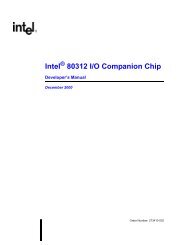Digital Subscriber Line Access Multiplexer (DSLAM) Example Design
Digital Subscriber Line Access Multiplexer (DSLAM) Example Design
Digital Subscriber Line Access Multiplexer (DSLAM) Example Design
You also want an ePaper? Increase the reach of your titles
YUMPU automatically turns print PDFs into web optimized ePapers that Google loves.
<strong>Digital</strong> <strong>Subscriber</strong> <strong>Line</strong> <strong>Access</strong> <strong>Multiplexer</strong> (<strong>DSLAM</strong>) <strong>Example</strong> <strong>Design</strong><br />
// Description:move mpacket to packet buffer and<br />
// update packet buffer address for next thread<br />
//<br />
// Outputs:<br />
// Now a global : out_exceptionif re-assembly failed, exception will be > 0<br />
//<br />
// Inputs/Outputs:<br />
// Now a global : rec_state mpacket status information<br />
// Now a global : packet_buf_addr sdram packet buffer address<br />
// Now a global : buffer_allocation_vector vector variable to keep track of<br />
which threads have a current buffer popped.<br />
//<br />
// Input:<br />
// my_mb this thread’s mailbox address for updated segment address<br />
// next_mb next thread’s mailbox address for updated segment address<br />
// next_tid next thread’s id for signaling<br />
// rec_req canned receive request for IX Bus<br />
// rfifo_addressrfifo address this thread will use<br />
//<br />
3.3.3 Transform Microblocks<br />
No transformations are done in the receive microblock group in the Transmit Processor.<br />
3.3.4 Egress Microblock<br />
One egress microblock is available for the receive microblock group in the Transmit Processor:<br />
• <strong>DSLAM</strong>_CopyEnqueue (enqueue to the traffic management system)<br />
The following function header describes the egress microblock. This function is contained in the<br />
files $Gen_<strong>DSLAM</strong>\hyannis\workbench_projects\dslam_proc_b_uC\main0.c and<br />
$Gen_<strong>DSLAM</strong>\hyannis\workbench_projects\dslam_proc_b_uC\main1.c.<br />
// ************************************************************************<br />
// <strong>DSLAM</strong>_CopyEnqueue<br />
// ************************************************************************<br />
//<br />
// Description:<br />
// Get the inter ixp header either from memory, or from the rfifo if sop.<br />
// Determine if the packet is flow control or data.<br />
// If flow control, then update the flow control table and set the bit<br />
// according the vc either on or off.<br />
// If data, then create a message for the tm41_receive code, and send it.<br />
//<br />
// Inputs:<br />
// Now a global : rec_statempacket status information<br />
// rfifo_addressrfifo address this thread will use<br />
// Now a global : packet_buf_addr packet buffer address<br />
//<br />
3.4 Transmit Processor Traffic Scheduler<br />
The TM4.1_Scheduler function schedules cells for transmit based on traffic contract associated<br />
with a VC. It schedules shaped VCs that have strict time constraints and unshaped VCs scheduled<br />
using the residual bandwidth after processing shaped VCs. The TM4.1_Scheduler function looks<br />
for work either from the message queue originating from the TM4.1_Receive function or a<br />
message queue originating from TM4.1_Shaper function. The schedule (comprising the VP/VC to<br />
be processed) for the shaped and unshaped VC is stored in a calendar queue.<br />
Application Note 21
















